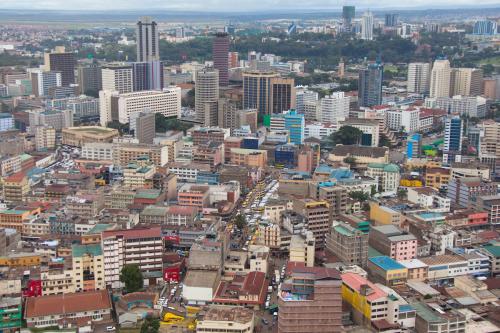

12:00 pm EST - 1:30 pm EST
Past Event
The growth of cities represents one of the most transformative forces shaping sub-Saharan Africa today. The current rapid pace and unwieldy nature of urbanization, however, has raised questions on whether the growth of African cities will lead to improved quality of life for Africans or exacerbate poverty and poor governance in urban hubs. To ensure that the former is realized, experts argue that now is the time to prepare, plan, and implement policies to effectively manage Africa’s urbanization. Chapter 4 of last year’s Foresight Africa as well as Chapter 4 of this year’s Foresight Africa discuss some of the strategies necessary for enhancing living standards and economic opportunities in African cities.
On Monday, December 12, the Brookings Institution’s Africa Growth Initiative and the Congressional African Staff Association (CASA) hosted an Africa Policy Dialogue on the Hill to discuss the challenges and opportunities presented by Africa’s growing cities, focusing on the drivers of the growth and strategies to meet the continent’s urban development objectives. Experts discussed mechanisms for securing sources of municipal finance and bridging the urban infrastructure gap, institutional factors influencing city governance and service delivery, and international partnerships for contributing to economic growth and positive social outcomes in Africa’s urban hubs.
Amadou Sy, senior fellow and director of the Brookings Africa Growth Initiative, gave opening remarks. Clare Romanik, urban resilience adviser for the U.S. Agency for International Development (USAID), moderated the discussion. Panelists included Remi Jedwab, associate professor of economics and international affairs at the George Washington University; Aymeric Saha, managing director of the Mobilizing Institutional Investors to Develop Africa’s Infrastructure project of the NASP-USAID Investment Partnership; and Chas Cadwell, director of the Center on International Development and Governance at the Urban Institute.
Romanik opened the discussion with some striking figures on African urban growth: By 2030, the 20 fastest-growing cities globally will be in some of the poorest countries in Africa, and sub-Saharan Africa will be home to five megacities (Kinshasa, Lagos, Dar-es-Salaam, Johannesburg, and Luanda). In addition, the number of large cities (with 5 million to 10 million people) in Africa will quadruple, from three in 2014 to 12 in 2030, and there will be 67 medium-sized cities (with 1 million to 5 million people) in the region. Jedwab explained the cause of this rapid city growth: While migration was a decisive factor in increasing Africa’s urban populations throughout the 1960s, today, natural increase is a greater contributor. High birth rates—women in African cities have five children on average—and lower death rates have led to significant natural increase in many cities.
As these self-increasing “mushroom cities” are growing so quickly—some doubling in population roughly every 15 to 20 years—Jedwab maintained that it is necessary for governments to keep building new infrastructure such as schools and hospitals so that they can provide public goods and services to their citizens. Yet, major infrastructure gaps exist already, and as urban populations continue to swell and their needs grow, these gaps may continue to widen. Jedwab recommended that one way of moderating the gap is by slowing down the growth of urban populations through family planning policies (including services and education)—as some rapidly urbanizing Asian countries have done. He also highlighted Ethiopia and Ghana as examples of African countries implementing such policies with some success.
Another way of closing the infrastructure gap in Africa’s urban hubs is by increasing financing for infrastructure. Saha discussed how, in large part, cities depend on federal government grants to fund their developmental spending, although there is some variability among African countries based on their levels of decentralization. He argued that a more decentralized system for revenue mobilization and allocation would better suit the needs of cities—although domestic resources alone will not be sufficient to fill the gap. He also identified new financing models for funding African infrastructure projects, focusing in particular on the USAID and National Association of Securities Professionals (NASP) Partnership, an outcome of the second U.S.-Africa Business Forum. The USAID-NASP Partnership provides structuring support for blended finance models, which enable institutional investors (such as pension funds and insurance companies) to partner with USAID and African entities so they can co-invest in transactions and financial vehicles that support infrastructure development. Since financing rates are higher in Africa than in other regions and infrastructure projects are long term, managing risk—often through guarantees from multinational development finance institutions—is important for attracting institutional investors to these opportunities in the region, according to Saha. To ensure good governance from all partners in the investments, each commercial transaction is structured based on mutually agreed upon rules, including reporting requirements and the establishment of a board of trustees.
While new financial tools could help raise the capital needed to invest in African cities, improvements in governance could also help make cities more responsive to the needs of their residents. Cadwell discussed the factors that contribute to public sector effectiveness and favorable urban service delivery performance in African cities, drawing on studies in Kenya and Tanzania, among other countries. Having sufficient local political “space” and dynamic local political leadership, maintaining adequate local control over administrative mechanisms and fiscal autonomy, and having robust local participation and accountability mechanisms are all important institutional factors that influence service delivery in cities. Even when a city has dynamic leadership, he noted, there can be constraints on resources and policy space for local government to affect change in service delivery performance. He remarked that understanding the local historical context that has led to certain modes of decentralization is important for determining areas for improvement.
Furthermore, Cadwell mentioned that many countries—as their birth rates decline, the number of workers increase, and their dependency ratios decrease—are asking how to best take advantage of their demographic dividend. This question is inherently tied to cities as most countries become increasingly urbanized, and cities have the potential to become centers of industry and job creation. He contended that making the most of the demographic boom depends in large part on boosting women’s labor force participation, education, and family planning; increasing connectivity; reducing corruption and rent extraction; and mitigating and adapting to climate change.

Muhammad Mustapha Gambo
August 15, 2023

Anthony F. Pipa, Kait Pendrak
June 28, 2023
2023
Online only
9:30 am - 10:30 am EDT